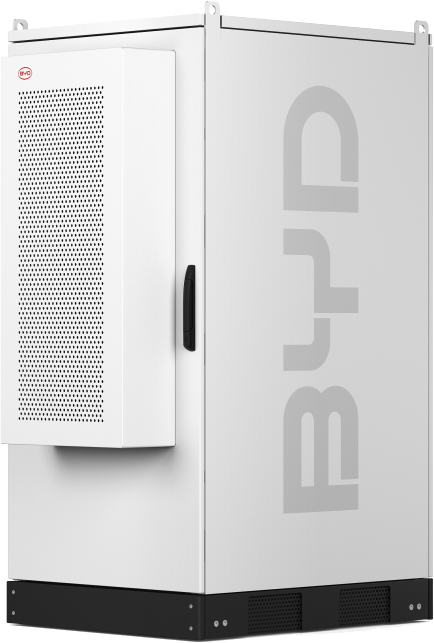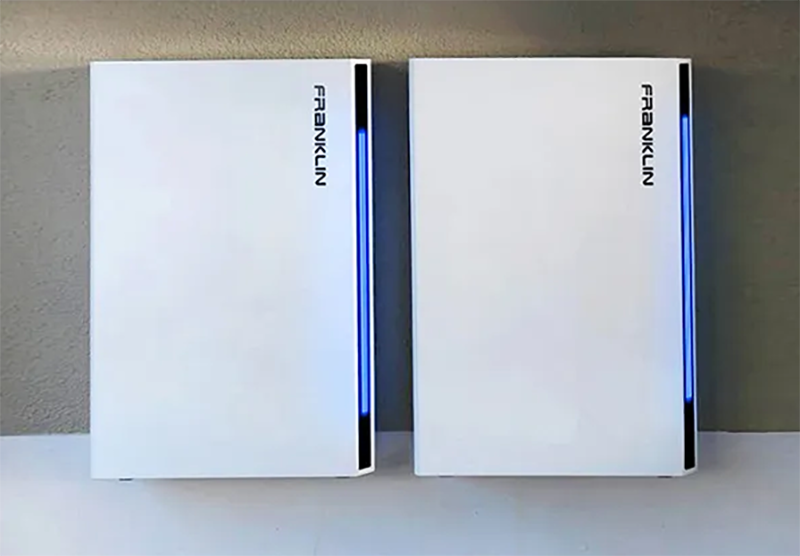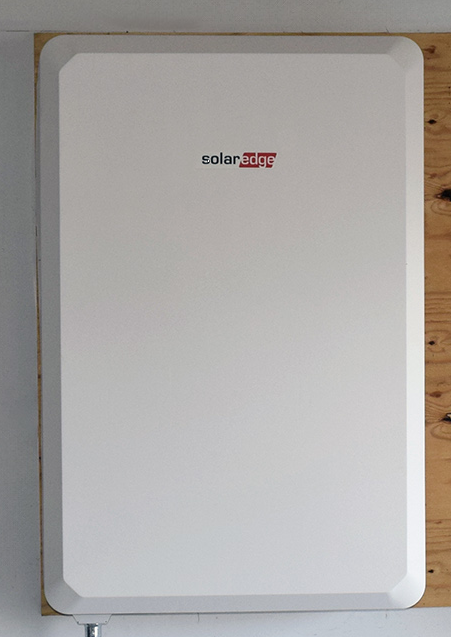About Battery Storage
How do Batteries Work?
Batteries are chemical energy storage devices. Most of us know a battery as an encased unit that can retain potential energy to be discharged as electricity. The differences in batteries arise from the materials used to create their component parts, namely the electrolyte and the two electrodes of different materials. When connected into a circuit, ions from one electrode move through the electrolyte (the conductive material around the electrodes and between them) into the other electrode, creating a flow of energy that manifests as electrical current. Many modern advanced technology batteries are fully sealed, with the electrodes connected to an external anode and cathode that conduct the electricity in and out of the battery. Other batteries require the addition of water to maintain the optimum levels of electrolyte concentration.
Each cell (a unit containing the two electrodes and the electrolyte) in a rechargeable battery (made up of one or more cells) uses the two electrodes to generate energy. The materials have been chosen because they can react and produce electricity that flows out of the battery (called discharge) as well as reverse the chemical reaction by receiving electricity from another energy source (called recharging). Over the years, people have discovered different combination of electrodes that meet a few important criteria:
Two Most Common Types of Batteries
Lithium-Ion – Given their reputation for being smaller and lighter, as well as having long cycle lives, these batteries are becoming more common for all battery storage. Mountain View Solar offers multiple types of lithium battery, including a self-heated model for off-grid applications.
Lead-Acid – Highly consistent, Lead-Acid batteries can be applied to any size project as they can be scaled up infinitely for the largest applications. They do have a lower depth of discharge than Lithium, so they require a larger overall capacity for the same true energy output, and they can be a bit complicated and require specialized labor to install. Some versions are flooded and require watering and maintenance, but for safety reasons Mountain View Solar will only install sealed, maintenance free batteries, so there isn’t a chance of gasses or acid leaking from them. Lead acid batteries are a very well-tested, established technology. The DEKA Unigy II industrial grade batteries that we recommend and install were originally designed for backup in the Telecom industry, so they are very well suited for residential and commercial backup with extremely long stand-by lifespan. Although lead is a toxic heavy metal, the lead in DEKA’s lead acid batteries is recycled from dead batteries; the recycling system for lead-acid batteries is well established.
With a properly engineered battery backup system, your refrigerator and freezer stay on, the well pump runs, and small appliances can be used. Harsh storms and utility problems can be gotten through much more comfortably. In addition, systems can be designed for long term preparedness to ensure that you have reliable uninterruptible power 24/7 for extended periods of time without utility power.
mtvSolar offers multiple types of battery systems:
- FranklinWH
- BYD or Socomec Industrial Systems
- SolarEdge EnergyHub
- enPhase enCharge
BYD, Socomec, DynaPower – Commercial & Industrial Applications

Demand charges are adders that utility companies charge commercial customers to ensure that they can deliver the maximum power ever needed by the client.Demand charges are based on the highest 15-minute average usage recorded within a given month. If the facility tends to use a lot of power over short periods, the demand charges will comprise a larger part of the bill. If the facility uses power at a more consistent rate throughout the month, the demand charges will generally be a smaller part of the bill.
In our area we’ve seen bills where demand charges comprise 50% or more of the total. The good news is that Mountain View Solar can help you slash demand charges in three ways:
- Install battery storage to store power and release it as needed during periods of peak load, therefore reducing demand charges from the utility. This implementation is called “peak load shaving”. Solar is not necessary but highly recommended.
- Install a solar PV array which will lower overall power usage.
- Analyze power usage patterns to help further reduce demand charges by changing how equipment is turned on, or adding controls to reduce surge loads. We have specialized sub-metering solutions to collect this data.
Unlike a generator, which requires time to come online and power loads, mtvSolar’s battery systems supply power quickly and silently.
Learn more about our commercial solutions: https://mtvsolarstorage.com/ci-solutions/
FranklinWH aPower – Residential, Off-Grid, Small Commercial
The FranklinWH aPower 2 is our premiere home energy storage solution that offers several advantages over its competitor, the Tesla PowerWall 3. It boasts a higher usable energy capacity of 15 kWh per battery with an additional 1 kWh reserve for black start, compared to the PowerWall 3’s 13.5 kWh with no reserve. The aPower 2 also features AC-coupled architecture for greater flexibility and easier retrofits, while the PowerWall 3’s DC-coupling limits flexibility and requires integrated inverters.

The FranklinWH aPower 2 is a home energy storage solution that offers several advantages for homeowners seeking reliable and flexible backup power. It boasts a substantial usable energy capacity of 15 kWh per battery with an additional 1 kWh reserve for black start, ensuring ample power during outages. The aPower 2 features AC-coupled architecture, known for its greater flexibility and ease of integration, especially for retrofitting existing systems.
Homeowners can rely on the aPower 2’s exceptional backup performance, particularly in larger homes and off-grid situations, ensuring a consistent power supply. The system is compatible with any 240 V, 60 Hz generator, allowing for versatile recharging options and uninterrupted power during extended outages.
Engineered for seamless integration with virtual power plants (VPPs), the aPower 2 boasts a higher storage capacity and a superior 15-year warranty, guaranteeing long-term value and performance. Its increased capacity translates to greater savings during peak energy periods, maximizing return on investment.
FranklinWH further distinguishes itself through its commitment to customer support. FranklinWH provides comprehensive 12-hour, 7-day support.
Learn more about our residential solutions: https://mtvsolarstorage.com/residential-solutions/

SolarEdge Home Hub – Small Residential
These systems have the following major benefits:
- Wall mounted lithium battery storing ~10kWh
- Optimized DC coupled Solar
- 10 year battery warranty
- Can stack up to 3 10kW inverters with up to 3 batteries each
- Generator charging
- Charge your EV during an outage
Learn more about our residential solutions: https://mtvsolarstorage.com/residential-solutions/
General Understanding of Battery Systems
Consider this: When the utility grid is operational, there is a limitless supply of energy. It is extremely reliable and constant. Day to day, you may not think about how much power you actually use.
However, once the grid fails and you’re running off-grid via solar and batteries, how you approach energy use must change drastically. There is a suddenly a very finite amount of power available. Even small appliances can use more power than you realize.
The energy stored in a battery is referred to as kilowatt-hours (kWh). One kWh is 1000 watts. Let’s assume for the sake of simplicity that you have a total of 20kWh of usable energy storage. This is the average size of batteries that we’ve historically installed. Let’s also assume for the moment that it’s nighttime and no solar energy is available.
If you run a 2kW (2000W) space heater at full power for 5 hours, that’s 10kWh of energy used. If you run the same heater for 10 hours, that’s 20kWh. Therefore, the 20kWh battery in our example would be depleted if that heater alone were run for 10 hours.
Conversely, a bunch of LED lights totaling 50w could run 24/7 for many days on that same battery, even without solar gain. To determine how much power that is, 50w = 0.05kW x 24 hours = 1.2kWh per day. This simple formula applies to all loads. Take the amount of wattage listed on the label multiplied by time to arrive at the energy needed for that load.
Mountain View Solar designs most battery backup systems to power certain “emergency loads”. These loads were discussed before the sale to determine how much solar and battery storage you’d need to operate day to day if the grid were to fail. Typical emergency loads would be a refrigerator, well pump, lights, microwave or coffee pot and some receptacles. Adding loads that weren’t planned for will deplete the battery sooner than expected.
One of the fastest ways to deplete a battery is via resistance heating. Even a small space heater as described above can quickly use up all the stored energy. Therefore, we typically avoid putting electric ovens, cook-tops, water heaters and heating loads in the emergency loads panel. Heat is best obtained directly via wood or pellet stoves, and propane heating appliances. Light bulbs should all be LED, rather than incandescent.
The lifespan of a battery is measured in cycles and depth of discharge (DOD). A cycle is defined as a discharge / recharge operation. DOD is defined as how much of the stored energy is used during that cycle before recharged completely. When a grid-tied battery backup is on standby, the batteries are in a “float” condition. This keeps them topped up to 100% charge and will last many years. Once the grid fails and that battery is cycled, the lifespan is reduced more rapidly. The lifespan can be increased if less power is used between the recharges, so conserving power is more important, even if ample stored capacity is available for use.
One way to avoid excessive DOD is to run larger loads only during the day when solar can help out. For example, run appliances only while the sun is up, or as close to sunrise as possible. This will enable the solar to run the loads rather than discharge the battery, and possibly recharge at the same time if extra power is available. Turn as much off as possible before sunset to retain as much energy in the battery through the night as possible.
Another solution is an automatic or portable generator. If your system is equipped with an automatic generator, the generator will start when the batteries reach a low state of charge, and recharge the batteries. It will then shut off automatically. If you have a portable generator, periodically check the battery charge level on your system’s control panel. If the battery level is getting low, fire up and connect the portable generator and the system will begin recharging the batteries.
Once utility power is restored, the system will automatically resume operation of the loads on utility power, fully recharge the battery, and begin floating it to be ready for the next outage.
It may be a good idea to perform a power outage drill. To do so, turn the main breaker in the service panel off to simulate a power outage. At this point, your emergency loads will be running on batteries and solar, off-grid. Observe how your use of energy affects the battery charge. Once complete, turn the main breaker back on to simulate restoration of utility power.
The description above is simplified as many technical factors affect batteries, lifespan and available power. However understanding these basics will enable you to maximize the use of your system.
